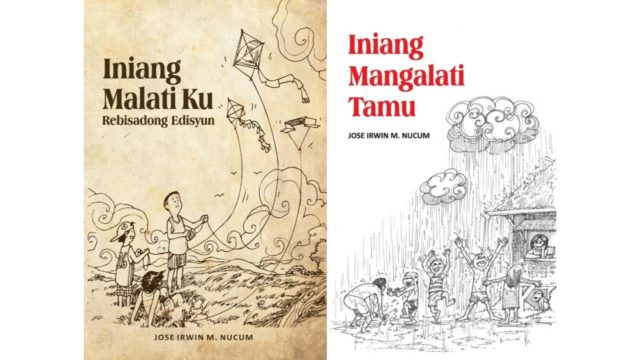The threat to our native language is real! Our Amanung Sisuan is constantly under siege and threat of possible annihilation by Kapampangans themselves who prefer to speak other languages except Kapampangan! The real threat to the life of the Kapampangan language are the Kapampangan themselves. To let our own language be extinguished is to let our own sense of identity be lost. Hence, we have to write, read and speak our language for its survival.
“Nung mamanagalug na la menasa ring Kapampangan, ding Taga Pampang sukat na lang mayaus Taga Ilog. Anti ta ne mo waring pepalbug kanita king malalam a dagat ning pamangalingwan ing amanu a tatak ning kekatang pangakilala antimong Kapampangan.”
“Nung alang misulat king Kapampangan, ala tamung abasa. Nung ala tang abasa, pagkasakitan ta yang abalu at ayapseng masalese ing salita tamung amana. Nung patitak nong paritak ding magsalitang Kapampangan, e malaut ing malumpawi ya ing maginhalu tamung amanu.”
To paraphrase, if there will be no books that would be written in Kapampangan, then there would be no reading materials that can guide the next generation in speaking the language well. With the gradual decline in the number of those who speak Kapampangan, the inevitable natural fate of our own language would be its demise and extinction.
SALVA VIDA THROWN TO OUR DROWNING LANGUAGE
Writing Kapampangan books goes beyond myself. My books and compositions in Kapampangan are my way of throwing salva vida (life saver) to our struggling amanung sisuan (‘sucked language from our mother’) amidst the rampaging waters of other languages ironically preferred to be spoken by our cabalens. Anywhere in Pampanga, you would hear many youth speaking Tagalog, Tag-lish and English, but not in Kapampangan. Your support to Kapampangan writings and music would greatly help in our advocacy to save our dying language. It is about time to fill our local libraries with Kapampangan books and music. I lament, “How many of us can still speak, read and more so write in Kapampangan now? Are we not slowly giving up our own sense of identity and heritage as a Kapampangan-speaking race?”
Seven years ago, I began rewriting the revised edition of my out-of-print maiden Kapampangan book Iniang Malati Ku (When I Was Young) and simultaneously started writing its sequel Iniang Mangalati Tamu (When We Were Young).
The upcoming 136-page Iniang Malati Ku The Revised Edition, which contains around 240 animated illustrations of artist Ramcos Nulud, narrates my personal adventures as a young Thomasian.
On the other hand, the 300-page Iniang Mangalati Tamu, which showcases around 435 nostalgic sketches also of Nulud, recounts our collective experiences as Kapampangans.
The drawings are meant to inject more life, fun and lightness as we relive our unsullied childhood days. Each of Nulud’s work is an attempt to further enliven our happy and memorable experiences then. Through each caricature, one can easily imagine the enviable kind of life we had in the past. Every image evokes a piece of sentimental nostalgia. In short, the nostalgic illustrations are meant to complement and enrich the stories.
Poet Laureate Felix M. Garcia, the long-time President of the Aguman ding Talasulat Kapampangan (Society of Kapampangan Writers), painstakingly edited both literary gems.
With much-improved writing style and orthography, fresh layout and new ISBN, the stories in Iniang Malati Ku The Revised Edition were retold in more fluid Kapampangan. On top of its more picturesque cover, its entire content got a well-delineated layout and presented with enlarged illustrations.
With 40% of its content presenting our nearly extinct native games, Iniang Malati Ku is an honest attempt on my part to provide an antithesis to computer games. Moreover, it aims to serve as a crude guide or manual in reviving our outdoor and indoor games as they teach us fair play, sensitivity to the feelings of our playmates and magnanimity in defeat.
Through faithful retelling of my candid experiences, I tried to recapture here the simplicity of family living, innocent childhood adventures, initial taste of learning, baptism of faith, unique music and arts, rich customs and traditions, early beliefs, tasty delicacies and local history in general.
Instead of just reprinting the original document of Iniang Malati Ku, I dared to rewrite it en toto with the helpful tips and leads of my 89-year old mother during our personal conversations in order to portray the narratives more accurately and faithfully as they truly happened.
The renewed interest of Kapampangans in our own identity and history and their heartwarming reception to Iniang Malati Ku gave birth to the more comprehensive Iniang Mangalati Tamu.
My new obra basically followed the structure of my first book as it boasts of additional chapters on our traditional way of living including the popular idioms, sayings and time-tested teachings of our elders. It resembles the famed “Book of Lists” as it unveils what generally matters in the life of Kapampangans.
COLLECTIVE SIGNIFICANCE OF THE BOOKS
As both books introduce the roots of our being Kapampangan, these unique treasures will be of great help in rediscovering our heritage ‘DNA’ as a race.
Serving as wellspring of our own sense of identity, both works are envisioned to help in the preservation and promotion of our native language, culture and heritage. As they mirror our simple yet happy way of living, these literary contributions in the annals of our local history are like small holes where we can have a peek of our rich past. It makes me happy to see that sweet smile in the lips of the reader as he browses on each story of our uncomplicated yet blissful life then.
Each book is a revelation of our simple yet happy life then – no pretensions and complications; despite our limited means of getting in touch with one another in the past, we could honestly say that our relationship with others is deep. The connection before is real and not barely wifi-dependent. Friendship then is genuine and not only virtual. We literally share our precious time to others by being with them personally.
In line with our mother tongue-based multilingual education (MTB-MLE), it is being hoped that both written works will be considered and offered as possible reading materials to Kapampangan learners. The closest language to anybody is his own mother tongue. We can feel best the story when we read and hear it in our native language. Hence, the best way to reach out and communicate to Kapampangans is through the Kapampangan language.
ARDUOUS YEARS OF PREPARATION
A friend curiously asked me with amazement, “How did you come out with all these nostalgic stories?” I reiterated, “One story at a time over a period of seven years.” Every time I recall an interesting one at any given moment, I readily save the topic in my cellphone so as not to forget it. Once I already have a good number of stories to work on, I would sit down, usually after my regular work, to write their respective details. Most of the time, I needed to do some research and personal interview to ascertain the correctness of my narratives.
MORAL RESPONSIBILITY OVER LIMITED READERSHIP AND MEAGER RESOURCES
One time my niece sincerely asked me, “Tito, why do you write your books in Kapampangan? You are well aware that you have already limited your readership ab initio. Will you still be able to get back the personal funds you have invested in publishing them?”
Because nobody will! “Seriously, as an author and composer, I continue to produce writings and compose music in Kapampangan without primarily thinking of the so-called return of investment (ROI) in the corporate world. I would rather take the risk for a greater investment – the unquantifiable fulfillment of having contributed in my own humble way a perpetual legacy to the next generation. While it was indeed a big ‘gamble’ on my part to write and compose in Kapampangan, it did not deter me in pursuing a personal advocacy which I’ve taken as a self-imposed moral responsibility upon my shoulders to bequeath the young with greater appreciation of our historic past and respect for our roots. For me, that would be a great investment to take and involve ourselves with.”
DEDICATION AND ACKNOWLEDGMENT
As I thank the Lord for the gift of writing, I am also forever grateful to my beloved parents for giving me happy childhood memories which are evidently the core of my vivid narrations in both books. It has been repeatedly said that one will be short in sharing fun-filled and colorful stories if he himself did not experience them during his younger days.
Both Iniang Malati Ku and Iniang Mangalati Tamu are lovingly dedicated to my family – the source of my happiness, the cradle of my meaningful existence and the fundamental reason to pursue good and excellence at all times.
All glory belongs to God! Metung ku mung lapis, ing Dios ya ing tune gugulis. (I’m just a pencil. It is God who truly writes).





